Members of the Civic Center Downtown Streets Team working a shift
He is sprawled out on the sidewalk, motionless, flushed cheeks framed by high cheekbones. He’s slender, probably in his mid-20s, his straight, coal black hair pulled back, and his orange t-shirt twisted up over his stomach. “He’s OD’ing on fentanyl!” shouts a guy holding a skateboard.
I dialed 911, relayed what I saw and heard, and asked the guy with the skateboard: “How do you know it’s fentanyl?” He gestures to the aluminum foil in the young man’s hand, apparently a telltale sign.
“Is he making any sounds?” asks the 911 dispatcher, who confirms the location at Jones Street below Post Street in San Francisco, and tells me that emergency responders are on the way. “He’s making loud, raspy, wheezing sounds,” I say. “Hold his head back!” the dispatcher instructs.
Just then a red station wagon pulls up and two first responders jump out. One is holding the opioid antidote, Narcan, which he quickly sprays into the young man’s nose. Narcan is a life-saving medication that reverses the fatal effects of opioid overdoses, and restores normal breathing. Suddenly, the young man springs up into a sitting position and his eyes pop open.
“Hi there, buddy,” says the emergency responder. He places an oxygen mask over the young man’s mouth and nose as he slowly sinks backwards and is caught by the other paramedic. An ambulance pulls up minutes later and the small crowd of onlookers disperse.
In 2020, during the COVID-19 pandemic, 712 people in San Francisco succumbed to accidental overdoses, 519 of those deaths involved fentanyl, according to preliminary data from the San Francisco Office of the Medical Examiner. Already from January through August, 457 people in San Francisco have died from accidental overdoses, 328 of those deaths involved fentanyl. Statewide, deaths from synthetic opioids, which include fentanyl and offshoots of it, skyrocketed 90% from 2018 (865) to 2019 (1,675), according to the Centers for Disease Control and Prevention (CDC). Nationally, opioids caused more than 70% of the nearly 71,000 deaths from overdoses in 2019, according to the latest CDC data.
Narcan reversed 2,600 overdoses in San Francisco in 2019, according to the DOPE Project, which partners with the San Francisco Department of Public Health. More recently, Helen Brooks was responsible for making three reversals happen.
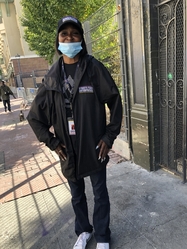
“I saved three people with Narcan,” she says, recalling an incident in August where she encountered three people lying on the sidewalk near one another on the corner of Taylor and Ellis streets in San Francisco.
Helen’s job, however, involves much more than reversing opioid overdoses. She and her colleagues in Streets Team Enterprises work in the streets to offer up food, water, and—to those with whom regular contact has sown trust—a bridge to the possibility of a stable life. This includes a job, a place to live, health care, a feeling of community, and help working through the underlying mess of traumatic life experiences that push people out on the streets, or into drug use to cope.
Helen knows that struggle all too well. “I had experience in saving people, because I used to be a user myself,” she says.
It’s been six years since Helen stopped using drugs. Now she is a supervisor with the Streets Team Enterprises, a subsidiary of Downtown Streets Team (DST), which has programs in 16 cities in Northern and Central California, including San Francisco, Santa Cruz, San Jose, Sacramento, Modesto and Salinas.
Team members, 60% to 70% of whom are unhoused, participate in street beautification, cleaning up trash, and are provided with leadership training and stipends in the form of gift cards. The value of the gift cards goes up from $100 to $360 a week, with increases tied to showing up regularly for shifts, working well with other team members and demonstrating leadership skills. In any given week, an average of 70 people are involved with the San Francisco Downtown Streets Team cleaning crews and other activities. In the past five years, 104 participants have found jobs and 100 have been able to find a place to live.
According to a 2021 anonymous survey of 250 participants, 100% said they were “proud to be a team member and to give back to the community.” Some 96% of participants report that participating in DST “improved their self-esteem, motivation and/or hope”, and 66 % report that they are “using less alcohol or drugs than they used to.” The survey also showed that 81% with mental health issues initiated or continued mental health treatment since joining DST. Some 86% now have health insurance and 96% report “positive health outcomes” due to their involvement with the program.
When Brooks began with Downtown Streets Team, she was “halfway homeless,” she says, living with her daughter part time and in a single residence occupancy hotel. She’s had a room in a hotel for the last 18 months while on the waiting list for permanent housing; her number is coming up soon. The responses to the survey square with her own experience of the Downtown Streets Team. “When my contract was about to end, my boss said, ‘You’re going to be promoted to supervisor!’ They kept believing in me,” she says.
Out on Ellis Street in San Francisco’s Tenderloin neighborhood, where much of the city’s homeless population dwells, Brooks talks to a man who’s lying on a makeshift bed of blankets and cardboard, gripping the leash to his chihuahua. “We’re trying to make sure he keeps his doctor’s appointment on Oct. 27. He had an accident and he injured his knee really bad,” says Brooks. She’s also trying to get him a shelter bed and food for his dog.
Brooks grew up in a large family and says that five of her siblings have died. She has 42 nieces and nephews with all kinds of emotional issues; she counsels and tends to them when they need help. It felt natural taking those life skills into the street.
“You have to be humble, because they’ve already experienced trauma. They’re out there on the streets. They don't know where they can use the restroom. They’re fighting with people on the street because they’re already in a bad mood,” she says. “I just talk to them like someone you love and care about. Sometimes they curse me out and say, get away from me. I’ll say, ‘If you’re not having a good day, I’ll come back later. if you do need anything, I’ll be here for you.’”
What makes Downtown Streets Team effective, says Romie Nottage, senior director of the Central Bay Area and Social Innovation, is that it is peer-led, focuses on successes large and small, and provides community and a safe space. It’s an antidote to the many institutions that have traumatized the populations they serve.
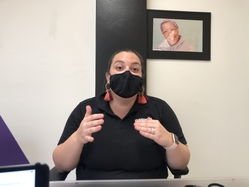
“The system, while it does help in many ways, does really disempower people from moving in an upward motion,” Nottage says. “For example, if you are on Social Security and you have a housing subsidy, if you get employed and want to move into a space that is more self-sufficient, you will lose your subsidy and you will lose your benefits like that!” She swipes her hands across each other for emphasis. “There are so many people who are going to become homeless if they get an amazing job—they’re stuck!”
To overcome that barrier, the program uses loopholes. The stipends that participants receive in the form of gift cards, for example, allow them to move forward without losing benefits tied to Social Security.
Downtown Streets Team is funded through grants and government contracts, with an annual budget of about $12 million for the entire agency.This helps them skirt typical institutional rules, says Nottage. “Because we’re not federally funded by, let’s say, Medi-Cal, we’re not necessarily held to the same rulebook that system-affiliated organizations are.”
Instead of diagnosing, assessing, or doing a lot of form filling, DST’s case managers, “ask what’s your favorite color, your favorite food, your favorite song,” says Nottage.
Such questions may seem trivial, but to Nottage, who was featured in the documentary The Wisdom of Trauma, asking those kinds of personal questions is a way to offset the harm that exposure to systems can cause. “There's always going to be that institutional kind of trauma through historical experiences, which people who have been homeless have all experienced, and which leads to mistrust,” she says.
Being homeless as an adult is also associated with a greater number of adverse childhood experiences, according to a study that was published in the Journal of Health Care for the Poor and Underserved. More than 66% of the study’s homeless participants had ACE scores of 5 or more, compared to 8.75% of the general population in five states. This study was modeled after the original CDC-Kaiser Permanente Adverse Childhood Experiences Study (ACE Study).
The original, landmark study, of more than 17,000 adults, linked 10 types of childhood trauma, such as experiencing abuse or living with a parent with mental health issues, with chronic health conditions in adulthood.
The study found that ACEs were remarkably common, with most people reporting at least one ACE. People who have four or more different types of ACEs—about 12%—have a 460% higher risk of becoming an alcoholic, compared with people who have no ACEs. (PACEs Science 101; Got Your ACE/Resilience Score?)
Fortunately, brains and lives are quite plastic. The appropriate integration of protective factors from positive childhood experiences—such as feeling supported by family and being able to share difficult emotions with them, having reliable adults outside of family who show they care, and developing trusting relationships with peers—can help people improve their lives.
Building trust to begin offsetting a trail of traumatic life experiences is shown by example in the DSTs weekly Success meetings, which give people a place to air struggles and praise team members for their hard work.
On a recent Tuesday, about 35 people gather at a Success meeting. Cornelius Dorsey, a program coordinator, introduces the different teams that go out to the neigborhoods; they stand up and are cheered. A team member, who’s a recent widower, talks about his own struggles and how he copes.
“When you feel pain, go harder; that’s what makes you successful, push through the pain,” he says to applause. A woman identified as Linda talks about how she’s happy to be back after a year. “I’m so grateful to be back; there are so many wonderful people here,” she says, choking back tears.
Dorsey praises the Civic Center team for de-escalating a situation in which someone was yelling at them, accusing them of taking his jar of marijuana and throwing it away. One of the team members calmly explained that they don’t pick up recyclables like jars, which finally defused his anger.
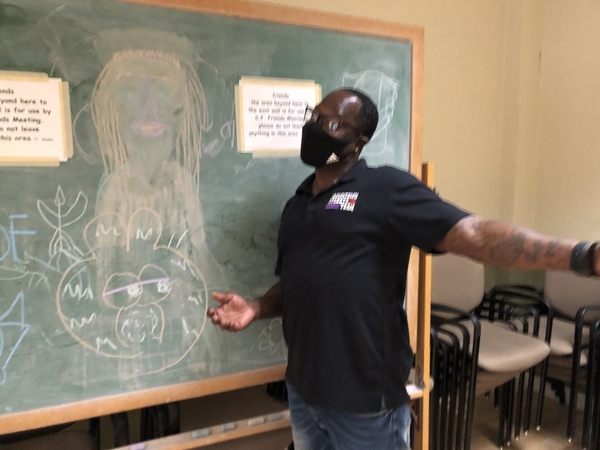
“I want to give the whole team props, because this could have escalated to a whole other situation!” Dorsey exclaims to applause.
Just after the meeting, Sherry Means, a supervisor for a shift that cleans up the streets at San Francisco’s Civic Center, heads out with a group of other DST members. She’s wearing a blue t-shirt, signaling her move to a supervisorial position. Her comrades in street cleaning all are wearing bright yellow t-shirts emblazoned with the words "Downtown Streets Team", as they push their trash bins and brooms and garbage pickers down towards Civic Center in a percussion of wheels.
Means says she came to DST initially in 2016 to get out of the house because she was bored. “I don’t like being around people. I don’t trust them. And I have a very strong threat response,” she explains. But little by little, the sense of community—and a women’s support group that DST brought in through a partner organization called the Blossom Project—helped her to better understand why she was often feeling under threat and how to offset it.
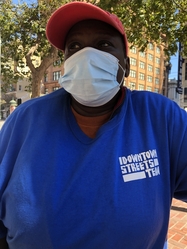
“I thought that when you’re picking trash, you’re just picking trash, but then I learned through meditation that thoughts are coming in and out. And because of my background, I often feel threat. So I learned when I come up to that feeling in my cave brain, I have to stop and think to myself, is there a threat? No there’s not, I’m just picking up trash, just leave it alone."
Those were skills that she says she picked up from the support group, which stopped meeting as lockdown for the pandemic was put in place. Looking back at her past, she knows where the feeling of danger comes from.
Leaning on her broom, she says that when she was 5 years old, “a man 27 years older treated me like a full-grown woman.” That, and a host of other abuses, dented her self-esteem, she says, as well as her feelings of safety. The group helped her build it back by sharing similar stories and showing her she wasn’t alone.
Her experiences underscore how the lack of a stable, caring adult in a child’s life, in addition to the abuse she experienced, can cause people to “stumble through their lives,” says Means.
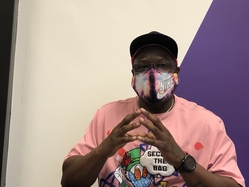
Kenny Davis, the operations manager of Streets Team Enterprises, is a drug and alcohol counselor who is also certified in anger management and domestic violence. He kept it hidden from his mother when he joined a gang at the age of 12. When she found out, he says, “I thought she was going to rain thunder on me.” Instead, he says, she told him not to bring “that stuff into the house."
"I almost took it as permission to be out here in the streets," he recalls. He says that his uncle was also involved with a gang and, as a kid, he was fascinated by the mystique around it. Davis ended up incarcerated at 22. It was the elders in prison who first provided that adult mentoring that he sorely needed.
“The older guys came in and started talking to me: ‘Hey, youngster, you need to start going to the library and start reading books!” He obeyed and eventually, while in prison, took and passed his General Educational Development exam. That was a turning point.
“It was a very eye opening, humbling experience,” he recalls thinking to himself, “If I can get my G.E.D., what else can I do?”


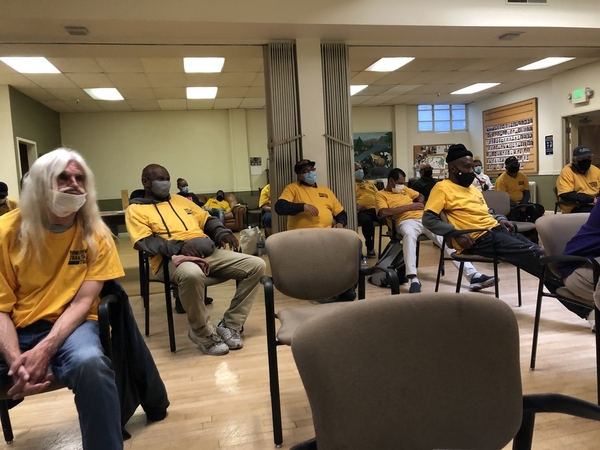
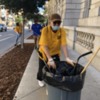






Comments (0)